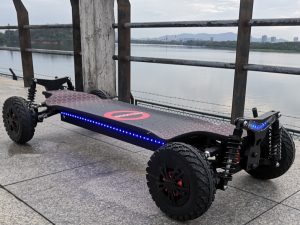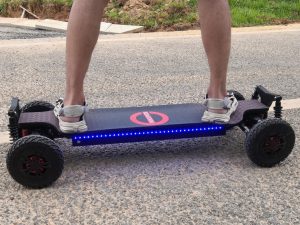Electric skateboards and Onewheels provide exciting new ways to commute and explore with eco-friendly electric power. But with different riding styles and strengths, which option best fits your needs?
This comprehensive comparison examines all the key factors to consider when purchasing an electric skateboard or Onewheel. Read on to gain insights to help you choose your perfect electric rideable.

Introducing Electric Skateboards and Onewheels
First, what exactly are these emerging transportation devices? Electric skateboards look like traditional skateboards but are powered by an electric motor and battery encased in the deck. Riders control speed and braking using a handheld wireless remote.
The Onewheel is a self-balancing electric unicycle with a single wide tire. Integrated sensors and gyroscopic technology keep the board level as you ride. Riders subtly shift their weight and position their feet on integrated footpads.
Now, let’s explore how the core performance, riding experience, and key features of electric skateboards and Onewheels compare.
Differences in Battery & Range Differences
When evaluating electric range, Onewheels currently fall short of electric skateboards. Most electric skateboard batteries reliably deliver 18-25 miles per charge. In contrast, Onewheels max out around 12-18 miles due to the extra power needed to balance the board.
However, the latest Onewheel models have increased battery capacity, helping narrow the gap. Cold weather and aggressive riding will also reduce real-world range on both vehicles. Battery life should suffice on short to medium-length trips for most commuting and recreation needs.
Differences in Speed and Acceleration
Electric skateboards have the edge when it comes to both top speed and acceleration. High-quality electric skateboards can reach speeds over 20 mph, while Onewheels max out at around 19 mph.
Onewheels limit speed more aggressively for safety reasons. Their solid tire construction also provides less traction at higher speeds. Electric skateboards accelerate faster and maintain faster cruising speeds with their smooth urethane wheels and optimized gearing.

Portability
At 25-30 lbs, Onewheels are bulkier and heavier than most electric skateboards. The heaviest skateboards weigh 25 lbs, but many compact models are under 15 lbs.
The extra weight does impact carrying an Onewheel any meaningful distance and can increase fatigue on longer rides. Many electric skateboards fold down into a more travel-friendly size as well. Overall, electric skateboards provide better portability.
Riding Modes
Higher-end electric skateboards often allow selecting between different speed modes for beginners or more experienced riders. Onewheels have a more limited top speed cutoff purely for safety reasons, without adjustable options.
So electric skateboarders can ease into the technology with lower learning modes or maximize performance once skills improve. Onewheels simply deliver one consistent riding experience focused on balance.
Terrain Tackling Abilities
With their all-terrain tire and cushioned ride, Onewheels excel at handling bumpy trails, grass, gravel, and other uneven surfaces. Electric skateboards use harder urethane wheels optimized for paved roads and paths.
Some electric skateboards come equipped with basic shock absorption or larger air-filled tires for added comfort and traction off-road. But in general, Onewheels are specifically built for mixed-terrain riding.
Control Differences
One of the biggest distinctions is in how each ride device is controlled. Electric skateboarders use an intuitive wireless remote to speed up, slow down, and brake. Leaning forward or back also steers the board.
In contrast, riding an Onewheel relies entirely on your body’s balance and positioning. You accelerate and steer by shifting weight between your heels and toes as well as twisting your hips. This takes considerable practice but allows carving and maneuvering in unique ways.

Safety Considerations
Both options come with safety considerations, but a few key differences emerge. Electric skateboards use gradual remote braking to slow down gently. Onewheels, max speed cutoffs can shut the motor power off suddenly, causing a dangerous stop.
Onewheels also have a higher riding stance than skateboards, increasing risks of falls and collisions. Overall injury rates appear similar, so responsible riding, protective gear, and built-in speed limits help maximize safety regardless of the electric vehicle choice.
Conclusion
When selecting an electric rideable, weigh your priorities in terms of performance, portability, and riding style. E-skateboards offer speed and convenience for urban commuters with their smooth acceleration, compact size, and intuitive controls. Onewheels provide a unique floating sensation and all-terrain versatility at the cost of a steeper learning curve.
Read More
- Electric Mountain Board Safety Gear – Ecomobl
- How To Choose The Right Electric Skateboard – Ecomobl
- Electric Skateboard Battery Lifespan – Ecomobl
- Off Road Electric Skateboarding Tips – Ecomobl
- Benefits Regenerative Braking Electric Longboard – Ecomobl




